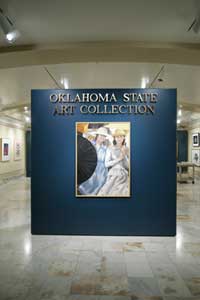The Betty Price Gallery

**NOTE:The Betty Price Gallery will be closed December 1, 2025, through January 19, 2026, so that exhibitions can be updated. The gallery will reopen Tuesday, January 20. Please check this page for updates.
2025 Grand Reopening
The Betty Price Gallery reopened February 25, 2025, in its new space on the heavily-trafficked second floor of the Oklahoma State Capitol. The gallery, originally located on the first floor, had been closed during the multi-year restoration of the Oklahoma State Capitol. A special grand reopening celebration took place on Tuesday, February 25, 2025, in the second-floor rotunda. Organized by the Oklahoma Arts Council, the event featured remarks by Governor Kevin Stitt and state legislative leaders. Following the event in the rotunda, attendees were able to view artworks featured in the inaugural exhibition.
About the Gallery
The Betty Price Gallery, located on the second floor of the Oklahoma State Capitol, houses the Oklahoma State Art Collection. The collection is a visual anthology of the history of artistic expression in Oklahoma. Curated by the Oklahoma Arts Council, exhibitions feature works of art by artists who were born in, trained in or have produced a significant portion of their work in the state.
The original Betty Price Gallery was opened on the first floor of the Capitol. Opened in 2007, the gallery was an official Oklahoma Centennial Commission project. Following renovations to the historic Capitol building, requiring closure of the original gallery for several years, the gallery was reopened on the heavily-trafficked second floor in 2025.
